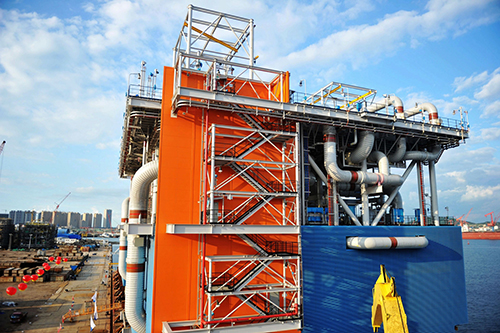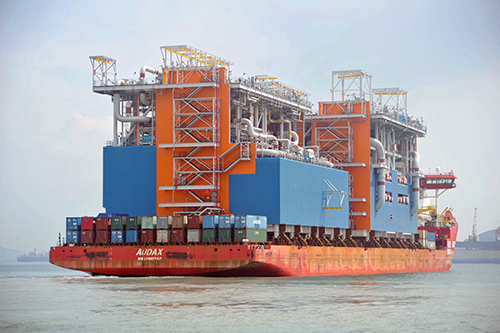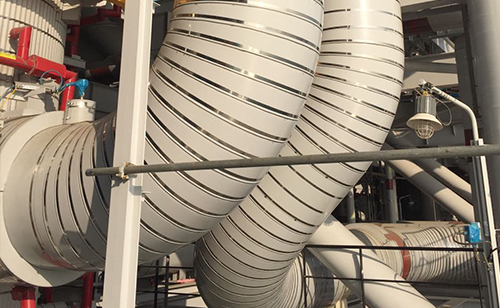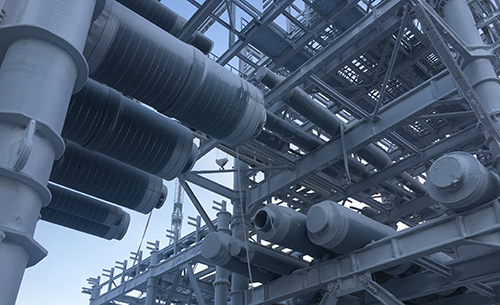What are the benefits of modular construction?
For LNG insulation projects.

Modular construction has been a fairly common practice for many types of projects across the world for more than a century. However, modular construction for LNG projects is a more recent event but modularization when used for large scale LNG projects bring a lot of benefits to the table.
Modularization
Modular construction has been a fairly common practice for many types of projects across the world for more than a century. However, modular construction for LNG projects is a more recent event. Traditional construction of an LNG project would consist of ‘stick build’ at the main construction site and would utilise labour from a large, local workforce. Alternatively, a modular construction approach can be employed and would involve the construction of prefabricated modules at sites other than the actual project site. This decreases the workload at the actual project site and often proves to be a viable, safe, cost-effective and environmentally friendly solution for many types of projects – including those in the LNG industry.
While it is not necessarily the solution for every project’s needs, modular construction has been shown to be one of the most beneficial solutions; even with the changing economy of today’s world. This is primarily due to the restructuring of corporations and LNG projects brought about by changes in both natural gas and crude oil prices. These economic shifts have caused many major projects to favour tighter schedules and budgets. Consequently, a viable solution is needed to allow for these projects to be carried out successfully and efficiently. This is where modularisation comes into play. It enables projects to be completed safely, on time and through a more budget-friendly, efficient and convenient approach.
THe pros of modularization
The modular construction model has been a popular choice with both offshore and onshore sites, and for good reason. All aspects of construction can be done in a modular fashion from the steel structure through piping and equipment, electrical systems, insulation installation and metal cladding. While this does require a bit of planning and coordination to ensure this pre-fabrication process will work for a specific LNG project at a given site, modularisation will typically decrease time in the field, which decreases labour costs. It also enhances safety, has fewer environmental impacts, provides higher efficiency for remote and harsh weather locations and improves construction execution.
In light of these observable benefits and the success rates of a number of recent projects, modularisation is growing in global popularity, and many more LNG projects are beginning to utilise it as an industry-approved approach.
Efficient transportation and construction
Thanks to today’s technologies, in particular effective transportation options and lifting equipment, it has been made possible for modular construction to be both an economic and efficient solution for LNG projects. Modularisation strays from the traditional method of using a large workforce at one main construction site. Through this approach, less work needs to be done at the main site, and pre-fabrication and pre-assembly can occur elsewhere, which conserves space, time and budget.
Once completed, these pre-constructed modules can be transported, usually via ship, barge and over land, to the main project site to be installed.
Transportation by ship across open water is extremely challenging. Modules will be exposed to rain water, salt water and moisture from condensation during transportation and corrosion under insulation (CUI) can occur before the modules are put into service.
safety
Worksite safety for LNG projects has – and always will be – a main driving factor for the implementation of a system, particularly regarding on-site construction.
The modularisation approach allows for lower exposure to field hazards, as construction occurring at the main site could mean disrupting or being caught up in daily and sometimes dangerous operations. This lowers a worker’s risk of being severely injured on the jobsite, interfering with daily tasks and interrupting schedules for other areas of the site.
Fire safety is also a critical safety factor in LNG facilities, as well as at the modular construction sites and aboard the module shipment vessels when being transported to the main project site.
Less labour required
Overall, the modular construction model requires less labour, which means sites will not need to hire and provide compensation for as many workers to complete a project. This can be especially beneficial in areas with limited labour pools which can make hiring a challenge.
One of the leading drivers for implementing modular construction is the effectiveness at locations with freezing or tropical temperatures. It may be difficult for sites to compile a team of skilled professionals willing to work in extreme weather conditions in a remote area within a reasonable budget. Fortunately, modularisation requires less time and less labourers when work is split between multiple sites; therefore projects in colder and more humid climates can be completed within a timely manner while staying within the approved project budget. With this in mind, companies concerned about their ability to hire skilled and affordable workers for a tropical or arctic site may want to consider modularisation for future projects.
Costs and convenience
As a whole, the modular construction method is more cost-effective than a traditional main site-built project. Aside from requiring fewer workers overall, the economic benefits of modularisation can be noticed in the fact that the project is completed in multiple pieces at varying locations, rather than all at once at one main site. This method can cut unnecessary costs and reduce the risk of any safety related accidents and replacements.
When it is time for modules to arrive to the main site for construction, many have found the process is less of a hassle than when assembly occurs entirely in one place. First, the modules do not take up as much space when they reach the main location, which means they can be stored and put aside until they are needed. As the modules take up less storage space, more work can be completed in a timely manner. Then, the modules are able to be moved easily and installed quickly, which plays an important role in the construction process, budget, timeline and standards.
Conclusion
Modular construction in the LNG industry has been proven to be a viable, safe, cost-effective and environmentally friendly solution. It provides for more efficient transportation and construction as well as job site safety. But, it also requires less labour and can reduce overall costs of the project.
FOAMGLAS® cellular glass insulation has been used on the majority of modular LNG constructions projects worldwide. The main reason for this is that we combine the unique blend of physical and insulating characteristics of our material with longtime experience in LNG modular constructions all over the world.







